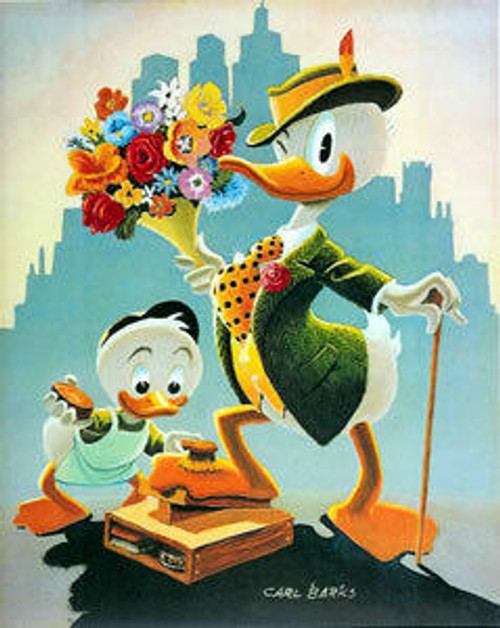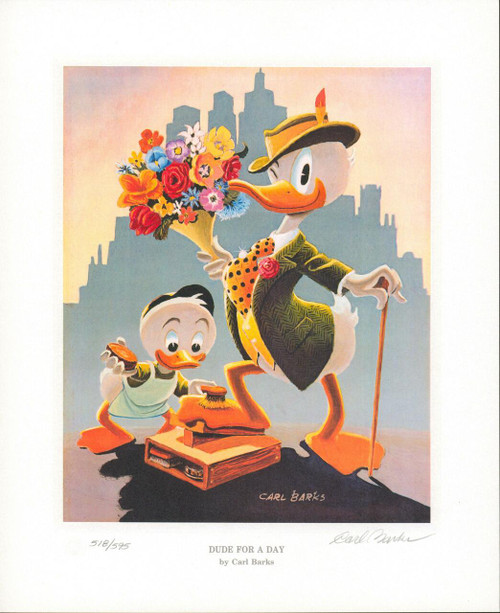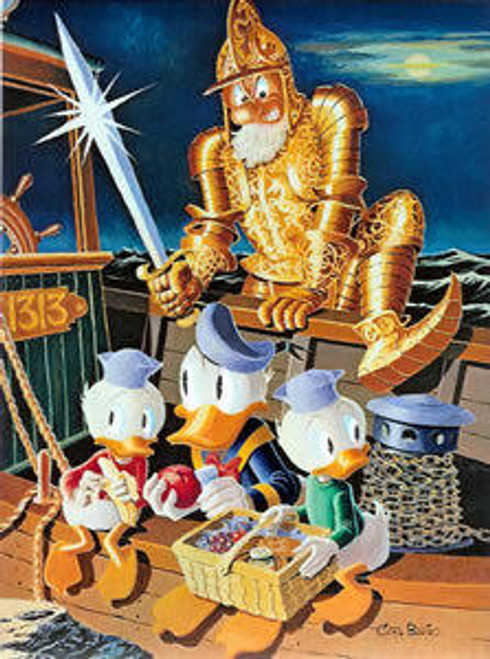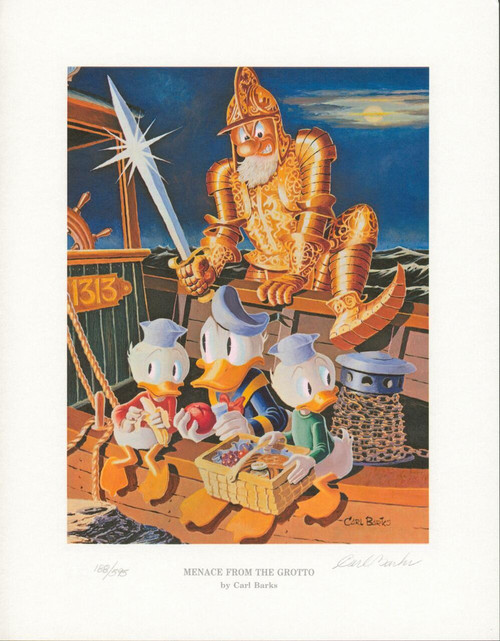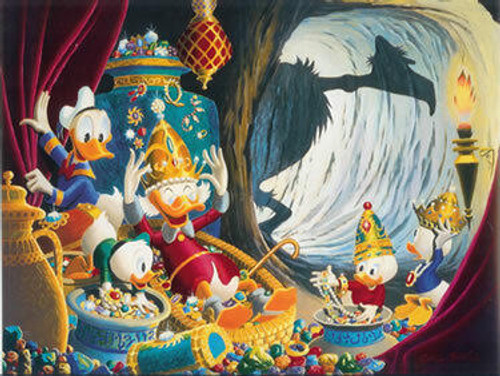Flubbity Dubbity Duffer’s origin and distinctive history are worth telling, for the facts will increase one’s understanding and appreciation of the painting and of the lithograph. This fascinating story began in 1952 when Carl Barks conceived a golfing gag for the cover to the May issue of Walt Disney’s Comics and Stories #140. The scene depicts Donald Duck digging himself deeper with every divot-churning stroke as a blustering duffer who finds himself hopelessly outmatched against an alert, amused Uncle Scrooge while being attended by his not-quite-so-watchful nephews, caddies Huey, Dewey and Louie. The elder McDuck was added by the artist almost as an after-thought as a result of the rapidly increasing interest that was developing in the miserly character following his debut three months earlier in the first issue of Uncle Scrooge (a title that rapidly became Western Publishing’s best seller). Barks liked the concept well enough to borrow it for an oil painting in 1972 (his nineteenth of 25 that year), and it was at that time the name Flubbity Dubbity Duffer was attached, an appropriately wild title for a zany image. Barks was well-known then for his “out-of-control” plots and escalation gags and Duffer fit that mold. It takes little imagination to assume what led up to Donald’s handful of irons and woods: if one club kept missing the fall -- not his fault, of course! -- surely eight clubs would do the job!![]() An additional 10 years passed and chapter three unfolded: Another Rainbow secured a license from Disney to publish -- in 30 volumes! -- 10 boxed sets of the 500+ stories written and/or drawn by the Old Duck Man: The Carl Barks Library. These sets were released in a random order, but the material contained was chronological in each. Set VIII, published in ’83, of The Carl Barks Library of Donald Duck was the first, covering Barks’ ten-pagers from Walt Disney’s Comics and Stories, beginning with issue #95 (August 1948), which had the first Barks cover done for the title through issue #166 (July 1954), the second “quarter” of his total output for WDC&S.
An additional 10 years passed and chapter three unfolded: Another Rainbow secured a license from Disney to publish -- in 30 volumes! -- 10 boxed sets of the 500+ stories written and/or drawn by the Old Duck Man: The Carl Barks Library. These sets were released in a random order, but the material contained was chronological in each. Set VIII, published in ’83, of The Carl Barks Library of Donald Duck was the first, covering Barks’ ten-pagers from Walt Disney’s Comics and Stories, beginning with issue #95 (August 1948), which had the first Barks cover done for the title through issue #166 (July 1954), the second “quarter” of his total output for WDC&S. ![]() Throughout our company’s association with the Duck Man we were continuously amazed at the coincidences surrounding his life product of Disney work. For example, the 26-years of covers and stories Barks did for this flagship comic book neatly divided into four parts for sets of equal size housing 12 volumes of the planned 30 that would be required to reprint in the Library all of Barks’ Scrooge and Donald pro-duck-tivity. The period from 1948 - 1954 is, arguably, his finest, funniest and most imaginative; in other words, it was a perfect set with which we could begin. Too, we knew Set VII, was going to be a problem, since Western Publishing’s files containing stats shot directly from his original art were spotty and incomplete in the early years. We decided to post-pone that set as long as possible. “Carl’s karma,” as we affectionally called it, seemed to dictate an orderly progression, so you can imagine our delight when the very first cover scheduled to be run -- in the first volume of the eighth set -- was the first he ever did for Comics and Stories! Another surprise was in store, however: when opening the package of photostats (we only chose the best one, in our estimation, of every three to be run -- to cut expenses -- planning the other two to be photographed directly from the publisher’s personal collection of original Dell collector comics). Donald’s face on the cover to #140 had something wrong with his eyes! The pupils were white, outlined, but not blackened in. No highlights, no pie cuts. Huh? This also was not the way the cover was printed in 1952 and not the way Barks painted the oil version in 1972. To make a long story short, we finally figured out -- and verified from Carl -- that the Duck artist originally intended for Donald’s eyes to be red! Western’s editors, though, left the art untouched, filming it as submitted. Somewhere between submission and printing someone “corrected the error” and blackened in Don’s pupils (Barks never did his own color guides as is common today). After 20 years -- in ’72 -- when doing the painting Barks simply forgot his original intention. So … when the Barks Library came out in 1983 the Old Duck Man’s initial idea was restored and Donald Duck saw red!
Throughout our company’s association with the Duck Man we were continuously amazed at the coincidences surrounding his life product of Disney work. For example, the 26-years of covers and stories Barks did for this flagship comic book neatly divided into four parts for sets of equal size housing 12 volumes of the planned 30 that would be required to reprint in the Library all of Barks’ Scrooge and Donald pro-duck-tivity. The period from 1948 - 1954 is, arguably, his finest, funniest and most imaginative; in other words, it was a perfect set with which we could begin. Too, we knew Set VII, was going to be a problem, since Western Publishing’s files containing stats shot directly from his original art were spotty and incomplete in the early years. We decided to post-pone that set as long as possible. “Carl’s karma,” as we affectionally called it, seemed to dictate an orderly progression, so you can imagine our delight when the very first cover scheduled to be run -- in the first volume of the eighth set -- was the first he ever did for Comics and Stories! Another surprise was in store, however: when opening the package of photostats (we only chose the best one, in our estimation, of every three to be run -- to cut expenses -- planning the other two to be photographed directly from the publisher’s personal collection of original Dell collector comics). Donald’s face on the cover to #140 had something wrong with his eyes! The pupils were white, outlined, but not blackened in. No highlights, no pie cuts. Huh? This also was not the way the cover was printed in 1952 and not the way Barks painted the oil version in 1972. To make a long story short, we finally figured out -- and verified from Carl -- that the Duck artist originally intended for Donald’s eyes to be red! Western’s editors, though, left the art untouched, filming it as submitted. Somewhere between submission and printing someone “corrected the error” and blackened in Don’s pupils (Barks never did his own color guides as is common today). After 20 years -- in ’72 -- when doing the painting Barks simply forgot his original intention. So … when the Barks Library came out in 1983 the Old Duck Man’s initial idea was restored and Donald Duck saw red! ![]() But the story of Flubbity Dubbity Duffer does not end there. In the early 1990’s, Another Rainbow acquired the rights to begin the creation of a planned series of ten fine English bone china figurines and a loss-leader book -- with exceptional, high production costs -- was done to promote them: Carl Barks and the Disney Ducks. In it, a double fold-out portrays the ten, only six of which were ever released, though all had been drawn in pencil concept detail by Barks. Three were produced, but didn’t get past the prototype stage, including Flubbity Dubbity Duffer. (We’ll leave to everyone’s imagination how Barks and the artisans at Connoissuer of Malvern, the studio who did the ceramics, worked out the problem of fastening Donald’s floating body to the rest of the figurine.) Carl laughed about one more challenge: everything being three-dimensional, Uncle Scrooge’s scorecard would have to be shown from the back revealing what hole they were playing and how Donald was doing! (As of the present, however, the former publisher admits having forgotten these details, though with some effort the numbers could be retrievable.)
But the story of Flubbity Dubbity Duffer does not end there. In the early 1990’s, Another Rainbow acquired the rights to begin the creation of a planned series of ten fine English bone china figurines and a loss-leader book -- with exceptional, high production costs -- was done to promote them: Carl Barks and the Disney Ducks. In it, a double fold-out portrays the ten, only six of which were ever released, though all had been drawn in pencil concept detail by Barks. Three were produced, but didn’t get past the prototype stage, including Flubbity Dubbity Duffer. (We’ll leave to everyone’s imagination how Barks and the artisans at Connoissuer of Malvern, the studio who did the ceramics, worked out the problem of fastening Donald’s floating body to the rest of the figurine.) Carl laughed about one more challenge: everything being three-dimensional, Uncle Scrooge’s scorecard would have to be shown from the back revealing what hole they were playing and how Donald was doing! (As of the present, however, the former publisher admits having forgotten these details, though with some effort the numbers could be retrievable.)![]() Much space has been taken here to detail some of these little-known aspects of the story behind Flubbity Dubbity Duffer. What remains to be said is that this is, we think, the funniest image -- and the most typical Donald Duck -- painting ever done by Carl Barks … and it made a beautiful continuous-tone print! It was the second earliest -- his 34th -- of over 120 paintings he did in the 1970’s that Another Rainbows chose to make into a lithograph. (See A Christmas Trimming, which was the first.)
Much space has been taken here to detail some of these little-known aspects of the story behind Flubbity Dubbity Duffer. What remains to be said is that this is, we think, the funniest image -- and the most typical Donald Duck -- painting ever done by Carl Barks … and it made a beautiful continuous-tone print! It was the second earliest -- his 34th -- of over 120 paintings he did in the 1970’s that Another Rainbows chose to make into a lithograph. (See A Christmas Trimming, which was the first.)![]() Chronology of the comic book cover art: Originally appeared (with Donald’s pupils black) May 1952, Walt Disney’s Comics and Stories #140. Reappeared in 1983 twice in The Carl Barks Library of Donald Duck , Set VIII, Volume 2, Page 427 and on the back cover of the same volume (Donald’s pupils were red).
Chronology of the comic book cover art: Originally appeared (with Donald’s pupils black) May 1952, Walt Disney’s Comics and Stories #140. Reappeared in 1983 twice in The Carl Barks Library of Donald Duck , Set VIII, Volume 2, Page 427 and on the back cover of the same volume (Donald’s pupils were red). ![]() Chronology of the oil painting: First appeared as Plate 31, Pages 128 - 129, in The Fine Art of Walt Disney’s Donald Duck by Carl Barks, its reproduction reduced from the original’s 20”x16” to a 12”x 9 1/2” image in the book..
Chronology of the oil painting: First appeared as Plate 31, Pages 128 - 129, in The Fine Art of Walt Disney’s Donald Duck by Carl Barks, its reproduction reduced from the original’s 20”x16” to a 12”x 9 1/2” image in the book.. ![]() The miniature lithograph of Flubbity Dubbity Duffer, with a 10”x 8” image on paper trimmed to 13 1/2 x11”, was photographed from Barks’ painting and printed in thirteen colors on beautiful, archival Opalesque Keramique TM by the Black Box of Chicago, a paper that is constructed of 100% cotton fiber for strength and longevity and guaranteed not to fade under normal, stable storage conditions for hundreds of years.
The miniature lithograph of Flubbity Dubbity Duffer, with a 10”x 8” image on paper trimmed to 13 1/2 x11”, was photographed from Barks’ painting and printed in thirteen colors on beautiful, archival Opalesque Keramique TM by the Black Box of Chicago, a paper that is constructed of 100% cotton fiber for strength and longevity and guaranteed not to fade under normal, stable storage conditions for hundreds of years.
CONDITION: BRAND NEW, IN ORIGINAL PACKAGING WITH CERTIFICATE OF AUTHENTICITY
 AUD
AUD






